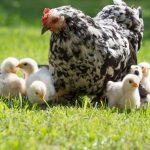 An egg once held the weight of a 200-pound man. Though small in stature, farm fresh eggs have big power. Their shells provide homes to growing chicks and shield yolks from harmful bacteria. But how can a structure that’s only 0.3 millimeters thick provide so much security? The answer comes down to design.
An egg once held the weight of a 200-pound man. Though small in stature, farm fresh eggs have big power. Their shells provide homes to growing chicks and shield yolks from harmful bacteria. But how can a structure that’s only 0.3 millimeters thick provide so much security? The answer comes down to design.
In fact, architects through the ages have modeled buildings after the dome of the egg. A dome shape offers strength and protection; any pressure applied to the top of the dome is spread throughout the structure. This simple power makes the egg one of nature’s leading designs.
Building an eggshell: Calcium and Vitamin D3
Similar to the supplies needed to build an architectural dome, hens require specific nutrients to produce eggs with strong shells. Calcium and vitamin D3 are two of the more important nutrients needed to build strong eggshells.
Calcium is the most important nutrient for eggshell development, and vitamin D3 is vital to getting the calcium where it needs to go. All told, each eggshell includes about 2 grams of calcium – or 40 percent of the shell.
This number has big meaning when looking at simple math. If the average backyard hen lays 180 to 200 eggs per year, that’s 0.8 to 0.88 pounds of calcium per year for eggshell development. This calcium must come from the diet to support eggshell production.
Calcium transport in eggshell production
After a hen consumes calcium, the nutrient begins the journey to eggshell production. It first enters the blood stream where it is carried to the shell gland and the rest of the body. To help calcium travel quickly enough to create strong eggshells, vitamin D3 also plays a large role.
Vitamin D3 is necessary, because it increases the rate at which calcium passes through the intestinal lining into the blood stream. The birds require large amounts of calcium when the shell gland is active. For this reason, layer feeds should also include vitamin D3: to get enough calcium to the shell gland when it is needed.
Providing the building blocks for strong eggshells
Hens need to consume around 4 grams of calcium each day in order to get the 2 grams of calcium needed to make one egg shell – not all of the calcium goes to making eggshells. As stated previously, the nutrient – along with Vitamin D3 – must come from the hen’s feed.
Be sure to provide hens a complete feed, like Purina® Layena® Pellets or Crumbles. This complete feed is formulated to provide the necessary four grams of calcium. On the other hand, the average scratch grains product provides only 0.1 grams of calcium and no vitamin D3.
For optimally strong shells and fresh eggs, choose a feed that also includes an oyster shell mix, like Oyster Strong™ System. This system is included in Layena® to provide a consistent supply of calcium through the entire 20-hour shell building process.
Oyster shell is a good way to provide calcium because of its large particle size. Smaller calcium particles break down quickly, but oyster shell particles have a slower transit time. This means the calcium source stays in the hen longer and plays an important role in eggshell formation at night when hens need calcium most.
Eggshells are created during a 24-26 hour process. Learn the magic behind farm fresh eggs here.
Source: Patrick Biggs, Ph.D – Flock Nutritionist, Purina Animal Nutrition



